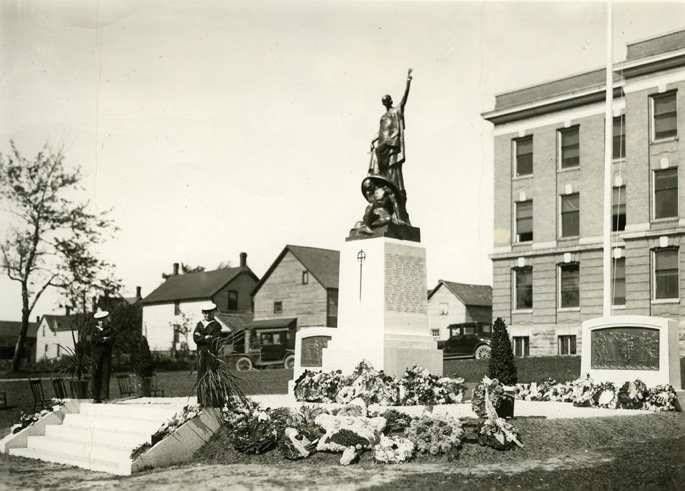
From the Sault Ste. Marie Public Library archives:
*************************
Every day Saultites pass the Cenotaph in front of the Sault Ste. Marie Courthouse not knowing just how special it really is.
In 1923, just five years after the First World War ended, citizens suggested a memorial to honour the war’s casualties.
At that time, a committee was formed, made up of representatives of local clubs and organizations.
In June of that year, eight Canadian sculptors were invited to submit designs for the proposed memorial.
A design submitted by Toronto’s Alfred Howell was eventually chosen.
The Cenotaph is the third of a group of four memorials designed by the artist.
His other memorials are in St. John (New Brunswick), Oshawa, and Guelph.
Howell’s Sault Ste. Marie design signified the “Triumph of Right over the God of War.”
On the memorial 'War' is represented by a crouching figure under the shield and 'Right' is signified by a draped figure holding a sword in her right hand and in her left a cluster of maple leaves.
Located on the north side of Queen Street in front of the Courthouse (426 Queen Street), the cornerstone of the memorial was laid by F.H. Clergue in August 1923 with tokens of the war dead placed inside.
A persuasive letter in 1924 from Sault Star editor J. W. Curran to Rudyard Kipling convinced the famous poet, in an almost unheard of request, to write the inscription that now appears on the memorial.
According to an editorial in the Toronto Evening Telegram, May 28, 1924, the requesting correspondence was a “masterpiece...a daring idea and (shows) persuasive skill of J.W. Curran”.
Kipling also lost a son in war and he wrote the following inscription to commemorate the loss of life through war.
From little towns, in a far land, we came,
To save our honour and a world aflame;
By little towns, in a far land, we sleep,
And trust those things we won
To you to keep.
— Rudyard Kipling, 1925
Inscription on Cenotaph
426 Queen Street East, Sault Ste. Marie
The foundation was laid in July of 1924 by contractor J.J. Fitzpatrick.
The monument was cast in Toronto and then shipped to the Sault.
More than 350 names of war dead are engraved on the east and west faces of the pedestal with Kipling’s specifically composed inscription on the front.
The names of the dead in World War II and the Korean War were added later.
The monument, which measures 22 feet high, was erected during the summer of 1924 and unveiled by Governor General Lord Byng in September 1924.
Due to some deterioration of the statue, a restoration committee was set up in the 1990s.
Perry Short, a local architect and veteran of WWII, designed the restoration and landscape architect, Kathy Smith, did the landscaping.
Throughout the year, wreaths are laid to commemorate important dates and battles in Canada’s military history during the last one hundred years.
Its location in front of the Courthouse makes it an important element and significant site in the Queenstown area of Sault Ste. Marie to this day.
*************************
Each week, the Sault Ste. Marie Public Library and its Archives provides SooToday readers with a glimpse of the city’s past.
Find out more of what the Public Library has to offer at www.ssmpl.ca and look for more Remember This? columns here.